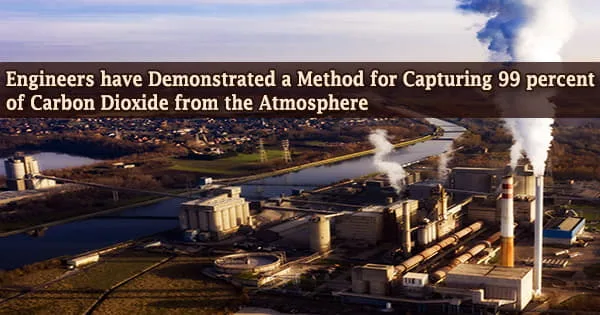Engineers at the University of Delaware have proved that a unique electrochemical device fueled by hydrogen can effectively capture 99 percent of carbon dioxide from the air. It’s a big step forward for carbon capture, and it could help bring more environmentally friendly fuel cells to market.
On Thursday, February 3, 2022, the research team, led by UD Professor Yushan Yan, published their technique in Nature Energy.
Game-changing tech for fuel cell efficiency
Fuel cells work by directly turning chemical energy from the fuel into electricity. They can be utilized in transportation for vehicles that are either hybrid or zero-emission.
Yan, the Henry Belin du Pont Chair of Chemical and Biomolecular Engineering, has been researching on improving hydroxide exchange membrane (HEM) fuel cells, which are a cost-effective and ecologically benign alternative to today’s acid-based fuel cells.
However, one flaw in HEM fuel cells has kept them off the road: they are particularly sensitive to carbon dioxide in the air. Carbon dioxide, in essence, makes it difficult for a HEM fuel cell to breathe.
This flaw affects the performance and efficiency of the fuel cell by up to 20%, effectively making it no better than a gasoline engine. For more than 15 years, Yan’s research group has been looking for a solution to the carbon dioxide conundrum.
Researchers noticed a few years ago that this disadvantage could really be a solution for carbon dioxide removal.
It’s risky, but we managed to control this short-circuited fuel cell by hydrogen. And by using this internal electrically shorted membrane, we were able to get rid of the bulky components, such as bipolar plates, current collectors or any electrical wires typically found in a fuel cell stack.
Lin Shi
“Once we dug into the mechanism, we realized the fuel cells were capturing just about every bit of carbon dioxide that came into them, and they were really good at separating it to the other side,” said Brian Setzler, assistant professor for research in chemical and biomolecular engineering and paper co-author.
While this is bad for the fuel cell, the researchers realized that if they could use this built-in “self-purging” process in a separate device upstream from the fuel cell stack, it might be used as a carbon dioxide separator.
“It turns out our approach is very effective. We can capture 99% of the carbon dioxide out of the air in one pass if we have the right design and right configuration,” said Yan.
So, how did they do it?
They discovered a technique to integrate the electrochemical technology’s power source inside the separation membrane. Internally short-circuiting the device was the method used.
“It’s risky, but we managed to control this short-circuited fuel cell by hydrogen. And by using this internal electrically shorted membrane, we were able to get rid of the bulky components, such as bipolar plates, current collectors or any electrical wires typically found in a fuel cell stack,” said Lin Shi, a doctoral candidate in the Yan group and the paper’s lead author.
The study team now had an electrochemical device that resembled a standard filtration membrane for separating gases, but could continually pick up minute amounts of carbon dioxide from the air, similar to a more intricate electrochemical system.
The device’s wires were embedded inside the membrane, effectively creating a shortcut for carbon dioxide particles to go from one side to the other. It also allowed the team to create a small-volume, helical module with a big surface area.
In other words, they now have a smaller container that can filter more air at once, making it both effective and cost-effective for fuel cell applications.
In the meanwhile, fewer components meant lower costs and, more significantly, a simple way to scale up for the market. According to the findings, a two-inch-by-two-inch electrochemical cell could constantly remove around 99 percent of the carbon dioxide found in air moving at a rate of roughly two liters per minute.
According to the researchers, an early prototype spiral device the size of a 12-ounce soda can is capable of filtering 10 liters of air per minute and removing 98 percent of carbon dioxide. The gadget, if scaled for an automobile application, would be around the size of a gallon of milk, according to Setzer, but it could also be used to remove carbon dioxide elsewhere.
The UD-patented technology, for example, could allow for lighter, more efficient carbon dioxide removal equipment in spaceships or submarines where continuous filtration is required.
“We have some ideas for a long-term roadmap that can really help us get there,” said Setzler.
According to Shi, because the electrochemical system is fueled by hydrogen, this electrochemical device could be employed in airplanes and buildings where air recirculation is needed as an energy-saving solution as the hydrogen economy develops. Shi will join Versogen, a UD spinoff business formed by Yan, to pursue research into sustainable green hydrogen later this month, following his dissertation defense.
Co-authors on the paper from the Yan lab include Yun Zhao, co-first author, and research associate, who performed experimental work essential for testing the device; Stephanie Matz, a doctoral student who contributed to the designing and fabrication of the spiral module, and Shimshon Gottesfeld, an adjunct professor of chemical and biomolecular engineering at UD. Gottesfeld was the principal investigator on the 2019 project, funded by the Advanced Research Projects Agency-Energy (ARPA-E) that led to the findings.





